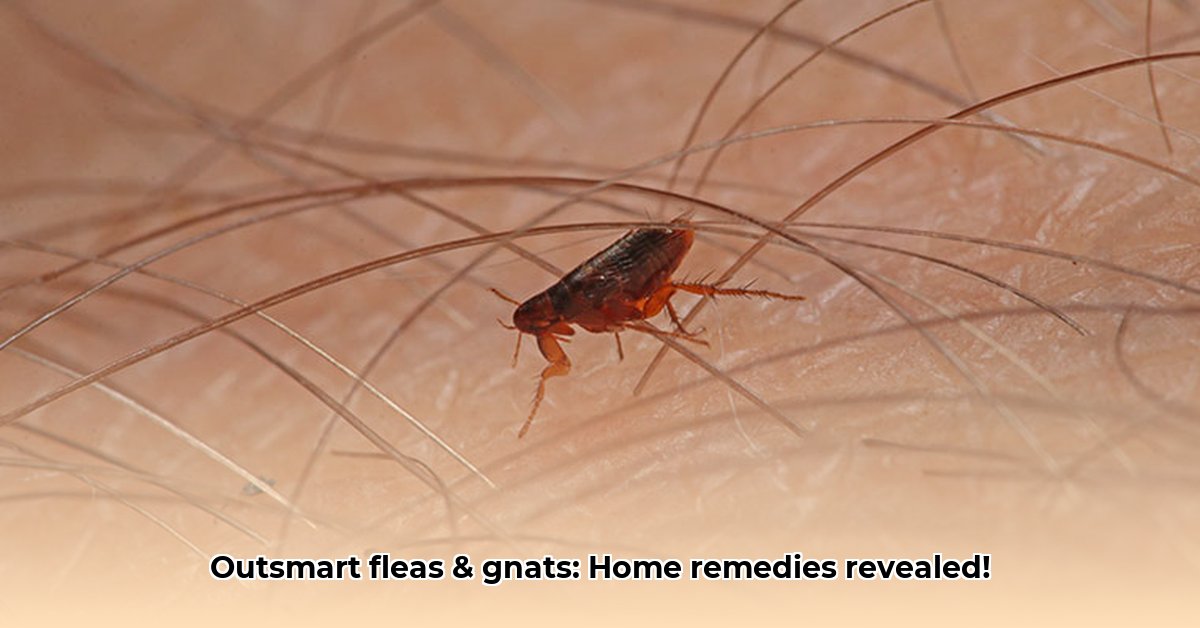Dealing with pesky biting insects can be frustrating, but you’re not alone! Many people confuse fleas and gnats, which makes effective pest control difficult. This guide provides clear distinctions and effective strategies to manage both. From identification and life cycles to step-by-step control methods for homeowners, pet owners, and professionals, we’ve got you covered. Learn how to prevent future infestations and keep your home pest-free. Let’s dive in! For more powerful solutions, check out these effective flea sprays.
Flea vs Gnat: Identifying and Eliminating These Common Pests
Let’s face it: tiny bugs can be a real nuisance. Fleas and gnats are two common culprits that can turn your home into a battleground for both your peace of mind and your health. This guide will help you identify, prevent, and eliminate these pesky pests with some environmental pest control and preventative measures.
Spotting the Enemy: Fleas vs. Gnats
First, you need to know what you’re dealing with. Fleas are small, dark brown or black insects often found on pets. Their most distinctive feature is their jumping ability, allowing them to leap surprisingly far. Gnats, on the other hand, are even tinier and have delicate wings. They’re often seen buzzing around plants or near damp areas. Think of them as the annoying little flies of the insect world, potentially spreading plant disease. If you see tiny, jumping insects on your furry friends, it’s probably fleas. If you keep swatting at buzzing insects near your houseplants or drains, those are likely gnats. A quick look with a magnifying glass might help if you’re still unsure.
Understanding Their Life Cycles and Habitats
Knowing how fleas and gnats live is crucial to getting rid of them. Both have a four-stage life cycle—egg, larva, pupa, then adult—but their preferred living spaces differ. Fleas love dark, damp places like carpets, pet bedding, and cracks in your floors. They’re masters of hiding their flea larvae. Gnats, however, prefer moisture. Standing water, damp soil in your potted plants, and overflowing drains are their happy places. They breed rapidly, so quick action is important for proper gnat control.
The Risks: Fleas vs. Gnats – What’s the Big Deal?
Both fleas and gnats present some level of risk. Fleas are known carriers of diseases, and their bites cause intense itching. Some people are even severely allergic to flea bites. Gnats, while generally less dangerous, can still transmit bacteria from contaminated sources, and their bites are irritating, potentially causing skin irritation and discomfort. Buffalo gnats, for instance, are known to bite humans and animals, causing painful welts.
Fighting Back: Integrated Pest Management (IPM) for Everyone
The best approach to dealing with fleas and gnats is a multi-pronged attack – the type of strategy that would make a general proud. We call it Integrated Pest Management (IPM), and it works! IPM focuses on long-term prevention through a combination of techniques.
Homeowners:
- Cleanliness is Next to Godliness (and Pest-Free): Regular cleaning is your first line of defense. Vacuum often, focusing on carpets, pet areas, and hidden crevices. Pay special attention to areas under furniture and along baseboards. This disrupts both flea and gnat life cycles. For gnats, cleaning kitchen drains and sinks regularly is exceptionally important to prevent the breeding process. Use drain cleaners containing enzymes or bacteria to break down organic matter that gnats feed on.
- Targeted Weapons: For fleas, you can use store-bought treatments designed for your pets, always following the instructions carefully. Flea traps can also be useful. Against gnats, try simple vinegar traps. These inexpensive traps attract and trap the gnats, reducing their numbers. Combine equal parts apple cider vinegar, water, and a few drops of dish soap in a small bowl. The sweet scent attracts gnats, and the soap breaks the surface tension, causing them to drown.
- Prevention is Key: Regularly inspect your home for signs of infestation. Address any damp areas immediately, which will go a long way to prevent gnats from moving in. Keep your home dry and well-ventilated to prevent future infestations. Install screens on windows and doors to keep both fleas and gnats from entering your home.
Pet Owners: You have a special challenge, since fleas directly target your beloved pets.
- Vet-Approved Solutions: Talk to your veterinarian about appropriate flea prevention and treatment for your pet. They can recommend products that are safe and effective. This is essential for both your pets’ well-being and to prevent your home from becoming a flea breeding ground. Options include topical treatments, oral medications, and flea collars.
- Grooming is Your Friend: Regularly brushing your pet helps you remove fleas directly. This simple method goes a long way in controlling an infestation and keeping your pet comfortable. Use a fine-toothed flea comb to effectively trap and remove fleas.
- Wash Those Pet Beds: Regularly washing your pet’s bedding helps to break the flea life cycle and reduce the number of pests. High heat during the washing and drying cycles is particularly effective at killing fleas and eggs. Wash pet bedding at least weekly in hot water and dry on high heat.
When to Call in the Experts
Sometimes, you need backup. If you’ve tried these methods and find yourself still battling a serious infestation, it’s time to call a professional pest control service. Experts have access to stronger treatments and the experience to quickly tackle the problem. They can also help identify the species of insect and recommend the most effective treatment for each specific pest. They can also advise on structural repairs or modifications to prevent future infestations.
Flea vs. Gnat: A Summary Table
| Feature | Fleas | Gnats |
|---|---|---|
| Size | 1 to 4 mm | 1 to 15 mm |
| Wings | Wingless | Winged |
| Movement | Jumping | Flying |
| Habitat | Pet bedding, carpets, cracks, dark areas | Damp areas, standing water, drains, plants |
| Diet | Blood (adults), flea feces (larvae) | Decaying organic matter, nectar, blood (some species) |
| Disease Risk | Moderate to High (though uncommon) | Low (generally, but can still transmit bacteria) |
| Appearance | Flat, brown or black, strong | Long legs, fragile, brown, black, or gray |
| Prevention | Protect animals, clean regularly, vacuum frequently | Take out trash regularly, keep sink clean, put away produce, don’t overwater plants |
| Control Methods | Flea treatments, flea traps, thorough vacuuming | Vinegar traps, drain cleaners, eliminating standing water |
In Conclusion: Winning the war against fleas and gnats involves vigilance, consistent effort, and sometimes, professional help. Remember, prevention is your best weapon. Keep your home clean, dry, and well-maintained. By taking proactive steps and understanding your enemy, you can keep these tiny terrors where they belong – far away from you and your pets.
How to Effectively Eliminate Fleas and Gnats Using Integrated Pest Management
Key Takeaways:
- Thorough cleaning is crucial: Vacuuming, washing bedding, and steam cleaning are essential for removing flea eggs, larvae, and pupae. Eliminate standing water for gnat control.
- Integrated approach is key: Combining pet treatments with environmental controls yields superior results compared to single methods. This tackles both adult pests and breeding grounds.
- DIY methods have limitations: While helpful for minor infestations, severe infestations often require professional intervention.
- Professional help is valuable: Experts offer targeted treatments and customized plans, especially for persistent problems. They also educate on how to effectively eliminate fleas and gnats using integrated pest management.
- Preventative measures are vital: Regular cleaning, proactive pet care, and sealing potential entry points help stop infestations before they start.
Identifying the Culprits: Fleas vs. Gnats
First, you need to know your enemy. Fleas are tiny, wingless insects that jump. Gnats are small, flying insects. Think of it like this: fleas are the sneaky ninjas, hiding in carpets; gnats are the buzzing messengers announcing their presence. Knowing the difference helps you target your efforts and use appropriate pest control methods. Consider using a magnifying glass or taking a photo with your phone to zoom in for a closer look.
Understanding Their Life Cycles and Habitats
Fleas have a complex life cycle—egg, larva, pupa, adult. Gnats also have multiple life stages. For example, fungus gnats, common in homes with houseplants, lay their eggs in the soil. This means a comprehensive approach is needed for complete elimination. For fleas, focus on eliminating breeding grounds (carpet, pet bedding). For gnats, tackle standing water and damp areas to disrupt their larvae development.
Assessing the Risks
Both fleas and gnats pose health risks. Fleas can transmit diseases, while gnat bites are irritating. Heavy infestations can also damage property, particularly with gnats infesting plants. This risk assessment will guide treatment choices and help prioritize prevention and control efforts. Remember that some people are highly allergic to flea bites and may experience severe reactions.
Implementing Integrated Pest Management (IPM)
IPM
- Your Perfect Bento Box Bag For Fresh And Tidy Meals - December 2, 2025
- Korean Meal Prep Made Easy For Delicious Weekday Meals - December 1, 2025
- Korean Food Meal Prep Makes Flavorful Weekday Meals Simple - November 30, 2025










